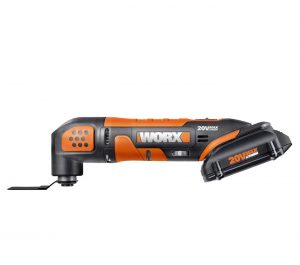Table of Contents
Introduction
Essentially, an oscillating tool is regarded as a jack-knife of power tools. Some of the various tasks that can be done with an oscillating tool include; grinding, sanding, sawing, cutting, scraping and to deliver clean results in tight quarters. People who commonly have oscillating tools in their toolbox include; tradespeople, carpenters, contractors, cabinet installers and flooring and not forgetting the passionate hobbyists.
Professionals love this tool, regardless of the job they perform. Learn more on what an oscillating too is and how it works here.
How Does an Oscillating Tool Work?
Since an oscillating tool buzzes the blade around the narrow arc, it does not release dust as a receptacle saw, jigsaw or high-speed rotary tool. Also, with the right accessory, the oscillating tool adds versatility to your project. The oscillating tool allows you to do the following;
- Plunge cut wood flooring
- Remove and clean grout
- Cut metal, wood, drywall, plastic and fibreglass
- Grind tile adhesive
- Flush – cut door jambs
- Cut baseboards and wood flooring
- Cut off bolts and nails and
- Scrape out old glue or caulk
What to Look Out For On an Oscillating Tool?
When it comes to the feature set, oscillating tools have are pretty much essential, however, there are a few things to look out when making your purchase;
- Accessory Change: Changing of accessory could a very straightforward process or end up becoming very challenging. Some professionals won’t even bother using a model that requires a tool to change the blade; they would prefer the starlock due to its ease of usage.
- Accessory Type: Do well to check what style of accessory the multi-tool requires. Keep in mind that Starlock models will not work with regular blades and the Festool has a different propriety system.
- Oscillating Rate: The rate of the top speed will determine how quickly the tool will cut. So you should look for at least 18,000 OPM.
- Oscillation Angle: The higher the angle of oscillation, the more aggressive it will cut. This implies the oscillating tool will have more speed, vibration and noise. Having 3.6o/3.7o, 1.8o to both sides is a stable balance.
- Vibration: When an oscillating tool has a lot of vibration, then it would be not easy to use. However, the Fein product is the preferred choice in this category, eliminating vibration in their latest line of work.
- Noise Level: Standard Noise level is measured at 92 dB (A) to 104 dB (A). It would be best to purchase less noisy multi-tool. However, it all boils down to what you’re comfortable using.
- Variable Speed Trigger: Some professionals prefer oscillating tools with an on/off switch plus a variable dial. Nevertheless, there are several trigger styles in the market, if you would love to go for that, then you should look out for the one with a lock-on switch, especially if your project involves sanding or scraping.
The Benefit of Using an Oscillating Tool
Although the regular use of oscillating tool involves sanding wood, fillers and hard finishes, however, one of the greatest perks you can get by using an oscillating tool is the versatility it provides you. Because, with the right attachment, you would be able to grind, remove tile grout, making plunge cuts or flush, cut door jambs and casings before a new floor installation, pipping and cutting metals, scrape out adhesives and other old paint.
Conclusion
Oscillating tools are multipurpose tools that serve as so many things, especially when you are carrying out various DIY home improvement projects or carpentry projects. Having this tool is availing yourself the opportunity to become very productive in your workplace.

